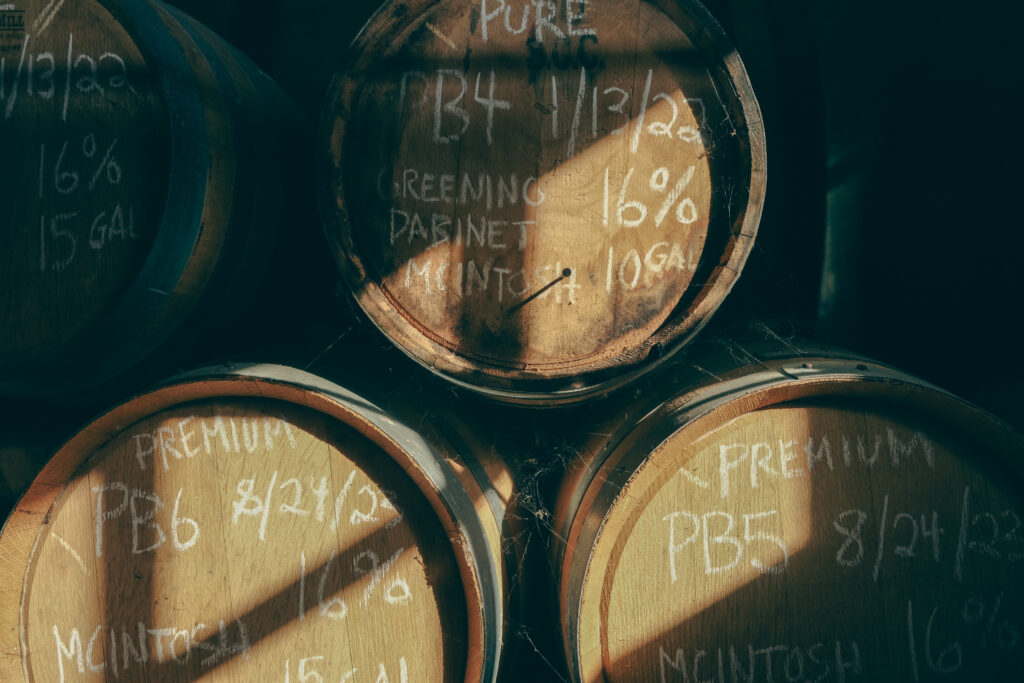Diverse takes on cider from Apres and Absolem
Written By: Becca Abramson
In the ever-changing world of craft beverages, Maine’s cider scene is a colorful patchwork of diverse techniques and philosophies. At one end, Apres in Portland curates a lineup of refreshing, approachable ciders that clock in around 6% ABV. In contrast, Absolem Cider Company, nestled in a historic barn in Winthrop, embraces the wild complexities of spontaneous fermentation, yielding funky, high-ABV ciders that flirt with the boundaries of wine. It’s this exploration of flavors and production methods that highlights the incredible variety of New England apples and the creative spirit of Maine makers who are changing the cider game.
Balancing Tradition and Innovation
Photographer-turned-cidermaker Larry Westler has always been fascinated by the sheer variety of apples available on the East Coast. “When you visit the grocery store, no one is referring to the blueberries or raspberries by name,” he says, “but when you’re looking at apples, there’s Macintosh, Red Delicious, Granny Smith, and a whole range of other types. At the farmers’ market or an orchard, there are 20, 30, even 50 varieties — it’s completely eye-opening.”
Growing up in New York City, Westler did his fair share of apple picking with family near the New Jersey border. Like many college kids, his introduction to hard cider came from packs of Angry Orchard and Woodchuck, before he discovered a handful of local establishments. “Eve’s Cidery in New York makes phenomenal orchard-based cider with heirloom apples,” he says, “and Bellewether Hard Cider and Wine makes a really approachable, clean cider. They both kind of opened my eyes to what cider could be.”
Westler, who currently leads cider production and R&D at Apres in Portland’s East Bayside, is well aware the business is known for a different type of alcoholic drink: seltzer (see “Don’t Hate the Fizz,” June, 2022, by Caleb Jagoda). “We’ve been making cider since the beginning — when the owners founded Apres, they intended for it to be a cidery and seltzer place,” he explains. As hard seltzer gained popularity, more resources were dedicated to the sparkling beverage. In March, Apres opened a new facility in Westbrook that handles the bulk of seltzer production, leaving the original tanks in East Bayside available for cider.
While many cideries use bulk juice (a mixture of dessert apple varieties that orchards often press for cidermakers), Apres places an emphasis on sourcing unique apple varieties from across the state. “A few years ago, we did a deep dive into all the orchards we could find and created a database of what’s available and where,” says Westler. “It’s really important for us to support orchards and farms of all sizes, because no one orchard can provide everything we need,” he adds. There are a variety of factors Westler considers when selecting specific varieties of apples: “Is it cider-specific? Will it hold up as a single varietal? Is it something people might not have tasted before? We try to keep an inclusive and accessible portfolio of ciders, but we also lean into some of the more complex and unique flavors.”
Once apples are selected and pressed, raw cider is transferred from a juice tote into one of Apres’ stainless steel tanks. Westler usually adds sulfite, and, 24 hours later, pitches the yeast. “I like to work backwards from what I’m trying to make when selecting a yeast,” he says. “Right now we’re making a plum cider that aims to be on the lower end of semi-dry, so we settled on a white wine yeast that’s similar to a Reisling. Ultimately, it depends on the flavor profile and final goal for the product.” After the yeast is added, the cider undergoes primary fermentation for two-to-four weeks before it’s transferred to another tank or into barrels to mature. “The longer you keep something in the tank, the less cider you can make,” Westler says. “We usually move it into oak barrels to mature, or we finish secondary fermentation in stainless steel barrels that won’t impart any other flavors.”
Most commercially available cider in Maine — including many of the varieties Westler makes at Apres — is produced at 6.9% ABV or below; any higher and the federal government gets involved. “Our philosophy here is to have easy, drinkable, crushable ciders along with a few complex options. We’re not watering anything down, we’re not using concentrate, and we’re not back-sweetening,” Westler says. He’s currently experimenting with a new beverage called cider kin, which involves rehydrating already pressed apples to make a weaker juice with perfumey, subtle flavors that results in a lower-alcohol product (around 2% ABV). “It’s too soon to tell how it’ll turn out,” he adds.
The Farmhouse Approach
About an hour north of Apres’ bustling urban seltzer and cider house, you’ll discover Absolem Cider Company, nestled on the western shore of Cobbosseecontee Lake. Housed in a charming 150-year-old barn on a sprawling 60-acre farm, Absolem specializes in cider crafted primarily through spontaneous fermentation. This unique method means no additional yeast is added to the pressed juice; instead, the indigenous cultures present on the apples and equipment naturally ferment the cider, creating a rich and authentic alcoholic beverage.
Kevin Sturtevant, co-founder and director of sales at Absolem, compares picking apples for cider to choosing grapes for wine. “The fruit has an amazing variety from season to season, but there’s also a great continuity in any given variety. Because we’re not always pitching yeast, our ciders don’t pick up those invasive yeast flavors,” so choosing the right variety of fruit is crucial. Apple selection is especially important in Absolem’s single varietal ciders. “People don’t often recognize how distinct, unique, and delicious independent apple varieties can be. For example, we have a new product called Under Veil that’s made entirely with Harrison apples, which is one of our favorite cider apples with a beautiful spikiness and citrusy character. We love to nerd out about this kind of thing,” he laughs.
In addition to cultivated varieties, Absolem incorporates foraged apples, sourced from roadside trees and abandoned orchards. “Wild apple trees offer incredible diversity. When foraging for uncultivated fruit, you’ll encounter unique flavors that cultivated apples, which are bred for sweetness and appeal, simply don’t have. Even crab apples, which people don’t usually eat, can make phenomenal cider,” Sturtevant adds.
Aging is another secret weapon for flavor at Absolem. “We have a garage full of over 60 barrels, from wines to whiskeys and everything in between,” Sturtevant explains. “It’s a really easy, effective way to manipulate the flavor of a product. It takes time to age and develop flavor, and it’s an art to know when to stop.” This process can lead to unexpected discoveries, both fortunate and unfortunate. “We have a cider we found in the back of the barn after two years that we thought we’d have to pitch, but we tried it and it was amazing,” Surtevant says. “Aging cider is exciting because it’s proven to be a really stable product, similar to wine.”
In addition to classic hard cider, Absolem produces a variety of co-fermented and blended beverages. “We craft a range of wines that we mix with cider in varying percentages. One of our best-sellers is Roses Red, which combines 20% Pinot Noir with 80% heirloom cider. It’s fruity, has a deep red color, and is incredibly refreshing at 8.4% ABV — just slightly less than wine, yet completely gluten-free.” The cidery also experiments with co-fermenting fruits like cherries, strawberries, and peaches alongside apple juice, resulting in robust ciders inspired by fruited lambics and skin-contact wines. “Because we ferment to fully dry and don’t stop fermentation, whatever the fruit brings in is what’s going to kick off the process. A lot of times we’re blending that with up to 50% or more of wine, so some of our products are 10% or 11% ABV just as a cider-wine hybrid.”
Maine’s Cider Revolution
The cider scene in Maine is characterized by a dynamic blend of knowledge and ingenuity among its makers. “Cidermakers in Maine are incredible because they’re all very generous and willing to share, whether it’s sources or knowledge or equipment. Everyone is so creative and they’re all pursuing what they want in different ways,” says Westler. This supportive spirit fosters an environment where innovation thrives as cidermakers experiment with various techniques and flavors. “Maine’s cider community is young, and it knows it,” reflects Sturtevant. “It’s kind of like a big workshop where everyone is at their table doing their own thing, occasionally walking around and saying, ‘Hey, cool!’”
As interest in cider continues to grow, Westler notes that the beverage has a unique appeal: “Every couple of years, people talk about how cider is going to become the next big thing. I think people get tired of beer, but cider has this extra mystique because you’re working with fruit and it’s not as mass-produced.” Sturtevant sees plenty of room for the industry to grow. “I think cider lacks a bit of an identity. It can mean a lot of things, in the way beer can mean a traditional lambic, pastry, sour, and everything in between.”
Ultimately, he believes that “more cider is good cider.” Whether you’re sipping a refreshing cider from Apres or a complex blend from Absolem, you’re experiencing the rich flavors and creativity that define Maine’s cider landscape.














